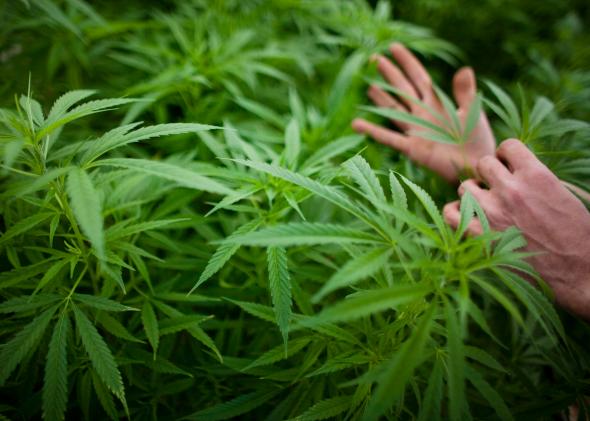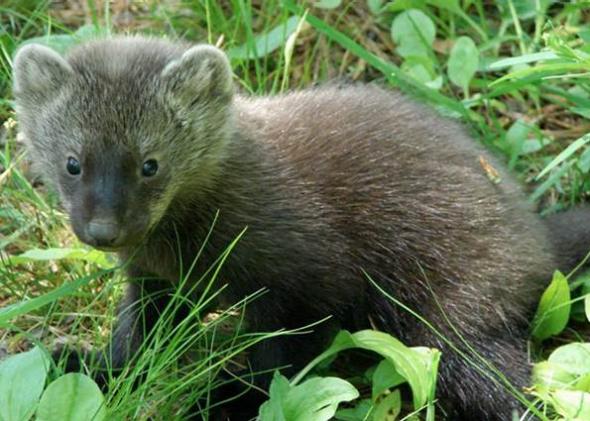
Green But Not Green: How Pot Farms Trash the Environment
New research suggests that unlawful marijuana farming is diverting water sources, poisoning animals, and increasing erosion.

Thinkstock
It began with dying weasels. First one, then many, all mysteriously killed by rat poison banned in the lush Northern California forests where the animals live. Damning evidence soon pointed to a surprising culprit: illegal marijuana farms, where growers use poisons to protect an increasingly lucrative crop.
But the damage caused by pot farms is greater than just one species of poisoned animal—it is far reaching, harming forests, streams, and broad wildlife populations. As states like California debate the legality of marijuana, new research suggests the discussion should focus not only on citizens’ right to smoke, but the broader impact of producing the drug.
There is a surprisingly strong environmental case to be made in favor of legalizing pot, because illegal marijuana is so bad for California’s wilderness and wildlife.
“It’s not just a moral and ethical debate,” says Mourad W. Gabriel, a scientist at the University of California, Davis, who helped unravel the mystery of the dying weasels. “It’s a major environmental concern.”
As the state continues to debate the merits of legalization—a vote on the issue isn’t expected until 2016—illegal farms in California are, according to some estimates, the largest source of domestically grown weed throughout the U.S. In Northern California, acreage devoted to marijuana operations has doubled in the last five years; locals call it the “green rush.” And the environmental impact of illegal marijuana farms is alarming, as research by Gabriel and other scientists has shown. Whole sections of forest have been razed and hilltops leveled to make room for the crop. The use of bulldozers has increased the threat of landslides. Streams have been dammed and diverted to provide water for the plants. Wildlife—from salmon to black bears—is increasingly threatened. Even indoor illegal growing operations are a drain on natural resources—a 2012 study said that segment of the industry could account for up to 1% of electricity consumption in the U.S.
Unlawful outdoor pot farms, including some operated by Mexican drug cartels, have caused the most damage. California’s murky marijuana laws—the state approves the drug for medical use but it is still illegal under federal law—has created a situation in which some farmers follow regulations while others disregard them completely. The damage is not limited to the so-called Emerald Triangle of Humboldt, Mendocino, and Trinity counties, the region most associated with pot growing. “You can grow this plant from sea level to as high as 7,000 feet,” Gabriel says. “If you have water available, if you have land that’s free, that you can trespass on—I have seen grow sites throughout the landscape of California. It’s prevalent everywhere.”
In 2009, Gabriel was tracking the Pacific fisher—a rare cat-sized carnivore in the weasel family that being considered for protection under the Endangered Species Act—when he found a deceased specimen with blood pooled in its abdomen. Gabriel was puzzled. The animal showed no signs of infectious disease, and anticoagulant rat poison, which causes massive internal bleeding when ingested, was not known to be used in the area. “We never suspected that this animal, that lives in a remote forest on national park land, to ever be exposed to this,” Gabriel says.

Photo by J. Mark Higley
Tests for rat poison came back positive, and soon more fishers were found dead on the forest floor. They, too, had consumed poison. As suspicion mounted, scientists tested tissue samples from 58 fishers in Northern California and found that nearly 80 percent had been exposed to rodenticide poisons.
As Gabriel investigated, he learned that use of rat poison is illegal on state land and forbidden on campgrounds. Utility companies are also barred from using poisons to protect power lines. In fact, some of the poisons discovered are banned entirely in the United States, including a type of poisons called carbamates, which have been used to kill wildlife in Africa. There were other oddities, as well: For example, Gabriel noticed the deaths were all occurring in the spring months.
Eventually, law enforcement officials suggested the animals might have been exposed to poisons found at or near pot farms, where rodenticide poison is commonly used to protect crops. Gabriel accompanied law enforcement on raids and found “massive amounts” of poison. Some sites were surrounded by dozens of poison-laced cans of tuna and sardines. Last July, Gabriel found a fisher that had died from eating one of many poisoned hot dogs strung around the site on a trotline. In 2011, a state game warden found a black bear and her cubs convulsing on the ground, having eaten into a stash of pesticides. Two threatened northern spotted owls tested positive for rodenticides, and gray foxes, raccoons, and other carnivores have also died also after consuming poison.
“When I went out there on days of raids on grow sites, on public lands, that’s the one thing that stood out: There’s this massive use of these chemicals,” Gabriel says. “These individuals are actually maliciously, intentionally trying to poison wildlife.”
These days, the majority of Gabriel’s research has shifted from tracking endangered fishers to the broader environmental impact of pot farms. In many cases, that impact is devastating. To create a grow site, traffickers create an unnatural trail system, and cut large sections of trees to make room for rows of plants. This altered habitat provides animals such as bobcats, mountain lions, and coyotes access to new prey, like fishers, which can take days to die after eating poison, making them like ticking time-bombs, poisoning the animals that eat them. The farmers also remove the remaining brush, which increases erosion.
Marijuana plants require a lot of water—depending on estimates, up to six gallons during a season—and illegal operations have tens of thousands of plants. To get water, farmers dam and divert streams or creeks, often drying them completely. Pesticide-filled cisterns feed miles of plastic irrigations lines. The camps are marked by trash dumps and human latrine sites right next to water sources.
Despite the growing problem, controlling illegal pot farms is difficult. For drug traffickers, the economic incentive is enormous. Gabriel says the farms produce anywhere from 1,000 to 10,000 plants, with each plant selling for $500 to $1,000 apiece. Last year, according to some estimates, Humboldt country’s marijuana crops alone brought in $415 million.
“If somebody is looking to make a substantial monetary gain, illegally, without paying for water or land, it’s pretty much free game,” Gabriel says. “These drug trafficking organizations capitalize on that, because it’s very difficult to patrol all the back wood areas of our national forest lands or national park lands.”
The camps and crops are often protected by armed drug traffickers; safety is a very real concern for scientists. Many have received threatening letters, and Gabriel’s Labrador retriever, Nyxo, recently died after eating poisoned meat tossed into the family’s backyard. Police are currently investigating.
While Gabriel, as an impartial researcher, doesn’t want to weigh in on legalization policy, his research and the threats against him and his work tell a clear story: illegal cultivation has costs far beyond the criminal justice system. If marijuana cultivation can be legalized and regulated across the board, then the environmental impact can be measured and mitigated as with any other crop. The murky half-legalization the U.S. currently has is untenable.
“We need to have a broader discussion across the political spectrum,” Gabriel says. “Are we content going down the same road we’ve been on? Or do we need to change things up in order to alleviate this impact?”